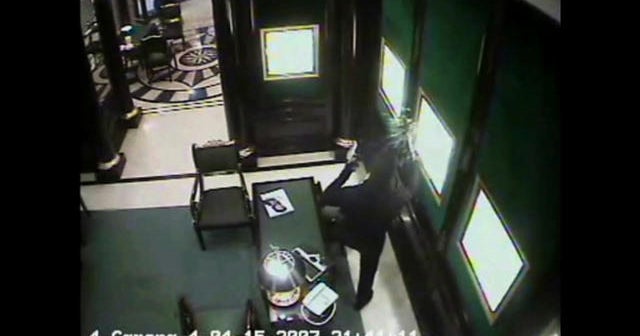The thieves who stole priceless jewelry from the Louvre are reviving memories of an audacious gang that stole $500 million in valuables in a series of daring heists that took place over nearly two decades.
The Pink Panthers targeted jewelry stores and museums in Europe and Asia and carried out some of the largest heists in history, raking in half a billion dollars worth of stolen goods between the early 1990s and mid-2010s.
There is no evidence that the theft at the Louvre is connected to the Pink Panthers, but the brazen nature of the robbery was similar to those carried out by the gang.
The Pink Panthers are a network of loosely organized teams, Interpol secretary general Ron Noble told “60 Minutes” in 2014. There are hundreds of gang members associated with the group. Most were from Eastern Europe, Noble said, and many fought in the Serbian Special Forces during the Bosnian Wars in the mid-1990s. The gang has no organized chain of command, Noble said, and uses experts in fields like safecracking, carjacking and more.
The Pink Panthers bring military discipline and expert planning to their thefts, Noble said, often doing weeks of surveillance and preparation before hitting their target. The attacks are carried out by small teams, typically in under a minute, and have well-planned getaways, Noble said. Once on the run, the gang quickly crosses international borders, often using fake passports.
One audacious robbery saw the Pink Panthers drive cars into a mall in Dubai before smashing into a jewelry store, stealing handfuls of diamonds and driving out — all in 45 seconds. They are responsible for the largest art robbery in Japanese history and the biggest jewel heist in Britain. In the latter incident, the thieves made off with $40 million of precious stones, including some hidden in a jar of cold cream. In San-Tropez, France, they escaped by speedboat after stealing $3 million worth of jewelry. In 2008, the Pink Panthers stole priceless paintings from an art museum in Zurich, Switzerland. The artworks were worth a combined $163 million, making it the largest art robbery in European history.
Law enforcement has been chasing the gang for years, Noble said. Interpol has identified 800 members of the Pink Panthers using photos, fingerprints and DNA, Noble said. Several gang members have been taken into custody, including one arrest in 2024. Some of their stolen goods — including the paintings taken from Zurich — have been recovered. However, diamonds and jewelry are difficult to recover, since the gems can be recut or turned into different pieces.
The thieves at the Louvre worked in broad daylight while tourists were already inside the famed museum. The thieves entered the museum with a crane-like lift, then smashed glass cases in the Apollon Gallery, home of the French crown jewels. They fled the scene on motorcycles, a museum spokesperson said.
The museum was closed after the brazen heist, and no injuries were reported. French officials said the robbery was carried out in just four minutes, and referred to the thieves as “professionals.” Criminologist Alain Bauer told CBS News that the thieves left behind DNA, which could be matched to information in law enforcement databases if the robbers are known to police. French police said supplies including a power saw, gloves, a walkie-talkie and a can of gasoline were also found. Bauer said the evidence will help police with their investigation.
“We will catch them,” said Bauer, who is a professor of criminology at France’s National Conservatory of Arts and Crafts. “I don’t think we will capture the jewels.”
The thieves took nine pieces from the jewelry collection of Napoleon III. One item — the crown of Empress Eugénie, made of gold, emerald and diamonds — was found apparently dropped outside the museum.
The other pieces stolen include a pearl and diamond tiara with over 200 pearls and nearly 2,000 diamonds, a gold corsage bow-shaped brooch with thousands of stones, a set of sapphire jewelry that may have once belonged to Marie Antoinette, an emerald necklace and pair of earrings that Napoleon gave his second wife as a wedding gift, and a diamond-encrusted brooch.
The jewels were of “inestimable value,” according to France’s interior minister and the museum. Despite their value, the jewels were apparently not in reinforced cases, art historian and former Louvre worker David Chanteranne told CBS News correspondent Elizabeth Palmer. For purposes of “historical accuracy,” the jewels were presented in their original cases.
There have been other notable heists at European museums in recent years. Thieves in Germany smashed into Dresden’s Green Vault museum overnight in 2019 and stole over $120 million worth of jewels. The robbers said in court that they used an axe to smash the cases and a fire extinguisher to hide their DNA. Some of the pieces they stole were recovered, but were damaged. Others have never been found.
Thousands of items were discovered to have been stolen from the British Museum in 2023. The small pieces were not on display and were largely used for research purposes. An employee was fired and the museum said they were seeking legal action against them. Some of the items have been recovered.
In 2022, a group of men broke into Germany’s Celtic and Roman Museum, in a heist that took place in just nine minutes. Cables were cut at a nearby telecommunications hub, leaving the area without communications networks. The thieves pried open the museum’s door, then smashed into a display case to take hundreds of gold coins that dated back to 100 B.C. They left the museum without triggering any alarms.
The men were arrested several months later. Three participants were convicted and handed prison sentences that ranged up to 11 years, while a fourth was acquitted of involvement in the theft but convicted on other charges. The treasure is still missing and appeared to have been at least partially melted down.
In 2020, a Van Gogh painting was stolen from a Dutch museum that was closed to prevent the spread of coronavirus. The painting was recovered in 2023, according to the Smithsonian.




